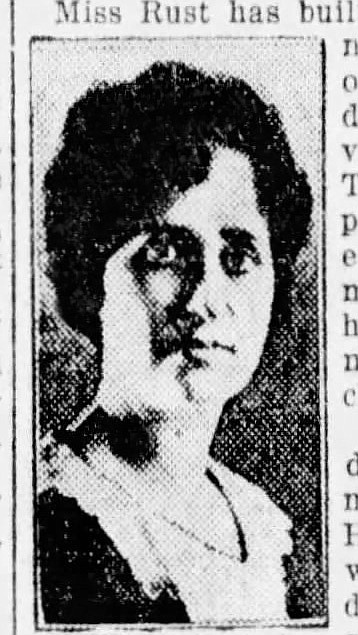An adventurous woman and an innovative entrepreneur, Ruth Rust operated her own photography studio for decades in downtown Jefferson City. At one time, she was the only woman in the nation to be a state's official photographer.
Although she provided a feminine touch inside her studio and was particularly skilled in working with children's portraits, Rust also served the Missouri Legislature and state officials from 1925-44.
She provided space at her studio, upstairs at 210 E. High St., in the Dallmeyer building, for women's groups to meet and hold exhibits. She also wasn't afraid to stand up to the system and challenge city laws.
Rust arrived in Jefferson City in 1921, when she bought the studio operated by Thomas Jack Simcoe. It is likely Simcoe contacted Rust after she ran an ad in Abel's Photographic Weekly: "All-round photographer would like position in studio which could be bought later; or to rent studio which would later be for sale. Town of 5,000 or more. Central states preferred."
Her studio already had seen more than 50 years of prestige in the Capital City as the "official studio of state officers and legislators," when she walked into 210 E. High St., or the second floor of the Dallmeyer Building.
The location first was the studio of F. Gustave Suden, remembered for his 1890 Souvenir Sketchbook, who was the General Assembly photographer from 1885 until about 1902.
The Dallmeyer Building studio passed to L.F. Miller, then to Ford and finally to Simcoe. So, Rust adopted a legacy for quality photography and a standard high enough for state officials.
She was the only woman serving as a state's photographer in 1935, and likely many other early years.
Rust also had the privilege to take the first contemporary Senate photo, which was hung in the new Capitol upon moving in and which ran in the Secretary of State's Blue Book.
Curiously, Rep. Edward M. Brady from St. Louis in 1935 declined to sit with Rust for the 58th General Assembly group picture, offering no specific reason for his refusal.
"This is the first legislator in her experience to refuse to have his photograph taken," she said.
Rust was introduced to photography by her older sister, Jennie, who was the first woman photographer in South Texas. By 1910, Rust had a studio in Buffalo, and in 1918, she moved her operation to Montezuma, Iowa.
A few years later, the 34-year-old arrived in Jefferson City. Other local photographers at the time included Ruby Weeks, Carl F. Deeg, Clara Rackers and Thomas G. Cooper.
One of her first ads in September 1921 said: "Miss Ruth Rust, the photographer, has made a special study of photographing the little folks and has the necessary patience for this work."
Within a few months, she also added a Kodak photo finisher, allowing next-day pick up for customers at 132a E. High St., which she shared with Weeks.
She was "ever alert to the new possibilities in her chosen vocation" the newspaper said.
In 1923, the local newspapers had not yet added photography to their regular design. Many of her portraits were featured on the society pages of local ladies announcing weddings, anniversaries, and positions within organizations. She also took photos of dance troupes and organizations. The Kansas City Star, even, picked up some of her work.
After three years in business in the Capital City, Rust was featured in the Kansas City Star's Women in Business column. The headline called photography an "ideal business for women."
Although her business was booming with state officials, candidates and notables visiting the Capitol, Rust "takes the most pride in handling the business of women and children," the article said. "Miss Rust's studio is distinctly a man-less affair. Her employees are women; and the decorations of the studio and furnishings are suggestive of the feminine."
Her work with children began with youngster photos, extended to Girl Scout Camp lessons in outdoor photography and included the Jefferson City High School yearbook, the Marcullus.
"The quality of photographic work produced by Miss Rust and her capable assistant, Miss Anne Milliken, won recognition throughout Central Missouri and has also played an important part in winning laurels for the local school publication in contests conducted throughout the state and nation," the Daily Capital News said in 1928.
She also worked for the Simonsenian staff to help provide a souvenir edition of the junior high school newspaper. And, Rust would provide to the public photo plates from special events, like ones of individual floats participating in the annual May Day and Health Day parade.
Today, along the limestone hallways of the Capitol, Rust's name and work remain on several House and Senate composite frames.
Michelle Brooks is a former reporter for the Jefferson City News Tribune. Her first book, Hidden History of Jefferson City" releases July 19. An expanded version of this story may be found in her second book, "Women of the Capital City."

